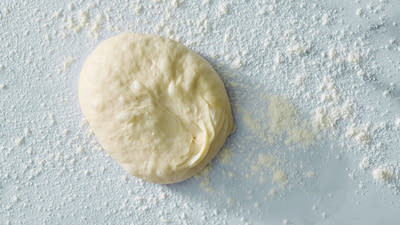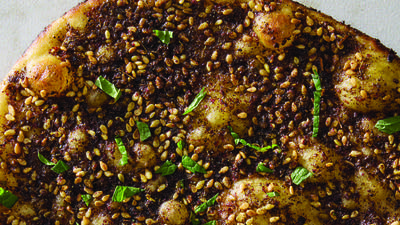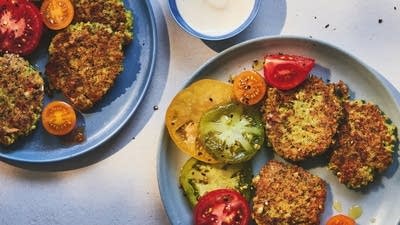
In its way, żurek—pronounced “zhurek”—is the most humble of all Polish soups, and at the same time the most exotic, at least to the foreign palate. It has traditionally been eaten at Easter, but now is found on menus all year-round. Though distantly related to the bread and garlic soups of Spain and Italy, its base is not meat or vegetable broth, but zakwas. Zakwas is made from rye bread and water and is, in turn, distantly related both to sourdough and to Russian kvass (a fermented drink). In Poland, zakwas is available in bottles at ordinary supermarkets. Outside of Poland, you can find it in specialty ethnic markets, and even online. If you do have to make it yourself, although it sounds odd and intimidating, it is in fact extremely easy. But it does require planning a few days in advance.
Żurek can be thin and delicate or hearty, stuffed with chunks of ham, sausage, and potatoes—in which case it is really an entire meal. The Easter version always contains biała kielbasa, or “spicy white sausage,” which is the same thing as bratwurst. Sometimes żurek, like its Italian cousin, zuppa di pan cotto, is served with hard-boiled egg. But it is always sour, salty, and creamy at the same time, which makes it unlike almost anything else.
Once you’ve tried it, the taste of żurek stays with you. Over the years Anne has encountered a number of Japanese who have been to Poland (there are more than you might imagine, such is the pull of Chopin’s birthplace). Almost every single one of them specifically mentioned żurek as the one Polish food he or she would never forget. Perhaps there is some mystical link between sour bread soup and sushi; we leave that for others to interpret.
Our version is on the lighter side, and cheats somewhat by making a vegetable broth during the cooking process, instead of using plain water. We also like the spiciness of horseradish here and, perhaps for similar reasons, we prefer sausage to egg. Use Polish biała kielbasa or bratwurst if you can get it, but if not, there are many lightly spiced chicken, veal, or pork sausages that would work here. They don’t have to be precooked, as they will be boiled in the soup.
(Lynne Rossetto Kasper interviews Anne Applebaum.)
Ingredients
For the zakwas:
1/2 cup/115 g rye flour
1 or 2 crusts from rye bread (about 1 cup/225 g total)
2 garlic cloves, minced
2 cups/480 ml warm water
For the soup:
2 large onions, peeled, one halved and one coarsely chopped
1 large carrot, trimmed and peeled
1 large parsnip, trimmed and peeled
1/2 celery root, peeled
6 cups/1.4 L water
2 garlic cloves, chopped finely
1/4 lb/115 g bacon (3 to 4 strips), chopped
2 1/4 lb/1 kg white sausage, cut into chunks
1 bay leaf
3 allspice berries
1 tbsp dried marjoram
6 black peppercorns
1/4 cup/55 g grated white horseradish (jarred is fine)
1/2 cup/120 ml light cream
Crusty brown bread for serving (optional)
Instructions
To make the zakwas: Place all of the ingredients in a large storage jar (a 1-qt/960-ml size will do) with a hermetically sealing top (such as you would use for preserving fruit). Leave the jar in a warm place—on a windowsill or in a cupboard—for 4 to 5 days. Open the jar, remove any mold or green bits that might have accumulated on top, and strain. The remaining sour, fermented liquid is the zakwas. You will have about 2 cups/480 ml for the soup. Set aside.
To make the soup: Place the sliced onion halves, carrot, parsnip, and celery root in a large saucepan with the water. Bring to a boil, lower the heat, and simmer, uncovered, for 40 minutes or so. Strain the broth and discard the vegetables.
Meanwhile, in a soup pot, fry together the chopped onion, garlic, bacon, and sausage over medium-high heat until all are lightly browned. Add the strained vegetable broth, the bay leaf, allspice, marjoram, peppercorns, and horseradish. Bring to a boil, reduce the heat, and cook at a low boil for 20 minutes. Stir in the reserved zakwas and the cream. Raise the heat, and bring to a boil again. Remove the bay leaf and serve, preferably with crusty brown bread on the side.
Anne Applebaum & Danielle Crittenden, From a Polish Country House Kitchen: 90 Recipes for the Ultimate Comfort Food, Chronicle Books (2012).
Before you go...
Each week, The Splendid Table brings you stories that expand your world view, inspire you to try something new, and show how food connects us all. We rely on your generous support. For as little as $5 a month, you can have a lasting impact on The Splendid Table. And, when you donate, you’ll join a community of like-minded individuals who love good food, good conversation, and kitchen companionship. Show your love for The Splendid Table with a gift today.
Thank you for your support.
Donate today for as little as $5.00 a month. Your gift only takes a few minutes and has a lasting impact on The Splendid Table and you'll be welcomed into The Splendid Table Co-op.



